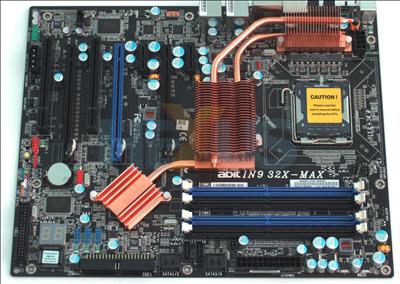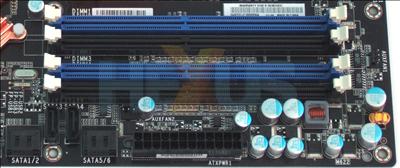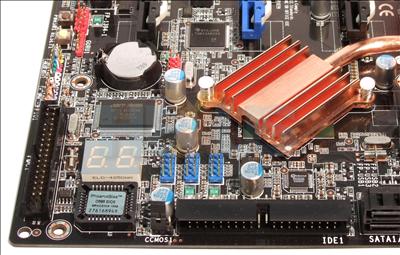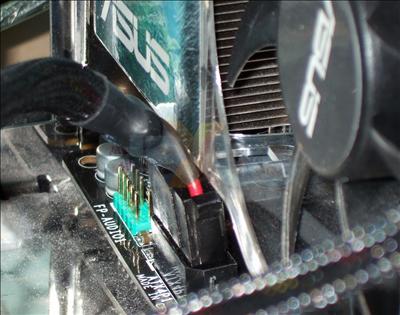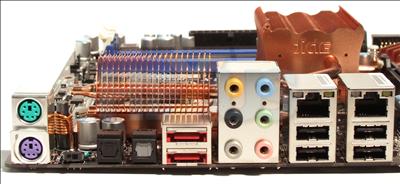Layout and features
NVIDIA's nForce 680i reference board design has proven very popular with board makers. Several companies, including eVGA and ECS, released boards virtually unaltered.
abit clearly doesn't think this is a good idea or, at least, not profitable enough, so the IN9 32X-MAX uses a custom PCB design.
The obligatory heatpipe cooling system runs from the southbridge heatsink to the larger heatsink on the northbridge heatsink then round towards the backplane.
As seems mandatory with contemporary high-end motherboards, abit has opted for a black PCB. This does make it look sophisticated but also means that, when combined with the black slots and connectors, we can't see much of the component placement without moving in a bit closer...
The nForce 680i SPP chipset is infamous for running hot, so using this board with water-cooling may require a fan to be added to ensure some airflow is reaching these heatsinks.
Unlike the reference design, the abit has digital PWM (Pulse Width Modulation) circuitry. This should help ensure a stable power supply even under heavy electrical loads. As well as going digital, abit has reduced the number of stages in the PWM design to five from the six used in the reference design's analogue version.
Digital PWM circuitry also helps keep a clean socket area, with no tall components in the heatsink exclusion zone.
Placement of the ATX12V connector could be more convenient, though. It's right alongside the final heatsink that's located near the backplane. That's great for getting extra juice to the processor but isn't ideal for cabling. We've seen even worse positions than that, though.
In contrast, the 24-pin EATX power connector is positioned almost perfectly - the bulky cable that goes to it can be easily tucked out the way.
The placement of the six SATA headers is a little strange. They're close to the front edge of the board - much further up than we'd normally expect. While headers 1 and 2 and 5 and 6 point sideways off the board, the ATX mounting hole prevents this orientation for the two headers in between. So headers 3 and 4 stand upright.
While this arrangement looks a bit odd, it shouldn't affect functionally. And, having the SATA headers close to the front edge of the board ensures that their cables don't interfere with longer graphics cards, such as the 8800 GTX.
Connectors for a floppy drive and a lone IDE channel are close to adjacent corners near the front of the board.
To the left of the IDE connector - and in a bit - is a POST diagnostic display that's handy for troubleshooting. Up past the floppy connector is a pair of buttons - for power and reset. They're very useful if running the board outside a case - for overclocking or general setting up.
The front-panel headers sit between those buttons and the floppy connector - and that's a far better position than on the reference design where they're located between a gaggle of connectors.
The layout of expansion-card slots - six in all - is identical to that of the 680i reference design.
Three are PCI Express (PCIe) slots. Two of those are fully 16x electrically, the third, in blue, is 8x electrically but in a full-length 16x slot. This arrangement allows two cards to be used at full-speed for SLI, with a slot spare for NVIDIA's proposed physics implementation.
The remaining three consist of a pair of PCIe 1x slots and one standard PCI. With six slots in total, the abit offers a good range of options, though limited choices when it comes to standard PCI cards.
A four-pin Molex socket sits close to the top edge of the board to provide additional power to the PCIe slots. However, the location of this socket means that there is a long stretch for cables, particularly to a graphics card in the top PEG slot.
And, if that Molex socket is used, the cable from it may foul the cooler on a dual-slot graphics card in the bottom PEG slot, as shown below. This doesn't stop the Molex socket being used but is a rather thoughtless oversight on a high-end board designed for SLI operation.
[advert]A large portion of the IN9 32X-MAX's back panel is given over to the cooling fins on abit's Silent OTES heatpipe system for the northbridge and southbridge.
As a result, there's no room for a parallel port, though few people will mourn its loss. Those who demand a bit of legacy support for old times' sake will have to make do with PS2 keyboard and mouse ports - alongside which is a far-from-old-fashioned BIOS-reset switch.
Sound is handled through an onboard Realtek ALC888DD Codec. This supports optical output for Dolby DTS Connect and Dolby Digital Live and there's an accompanying S/PDIF optical input, too. Six stereo mini-jacks are also fitted, supporting up to eight-channel output, plus mic, headphone and line-in connections.
Rear sockets are rounded off by four USB 2.0 ports, two Gigabit Ethernet ports and a pair of eSATA ports that are connected via a Silicon Images Sil3132 controller.
Summary
Barring a couple of wobbles with placement of the additional connector for PCIe power, abit has done a good job laying out the IN9 32X-MAX.
That said, we never had any major issues with the reference design. Unless the changes can yield improvements in overclocking or performance, it does feel a little like re-inventing the wheel for the sake of it.






